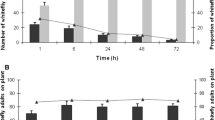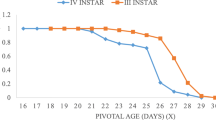Abstract
The pepper-fruit-borer Symmetrischema dulce Povolny (Lepidoptera: Gelechiidae) is an important chili pepper pest causing significant yield losses. However, chili pepper has insufficient crop protection support and primary information about S. dulce is scarce. In the present study, we aimed to study the biology and ecology of S. dulce in pepper plants (Capsicum frutescens L.) focusing to support integrated pest management programs. In the field, we sampled ripe and unripe chili pepper fruits in three different plant strata. In the laboratory, we established colonies of the S. dulce and we recorded the duration, viability, morphology of each life stage, and number of larval instars. We conducted experiments to evaluate insect reproduction, whereby we registered the pre-oviposition and oviposition period, daily oviposition rate, and sex ratio. From these results, we estimated the reproductive success of S. dulce through the intrinsic population growth rate. The higher occurrence of S. dulce was in unripe fruits with no difference between plant strata. Egg stage lasted 4 days with 94% viability, and larval phase lasted on average 10.72 days and presented four instars with viability of 66.6%. Pupal stage lasted 9.61 days with viability of 94.73%. The adult stage lasted 24.14 days with a pre-oviposition period of 3 days and oviposition period of 13.85 days. The intrinsic growth rate (rm) recorded was 0.0035. Our results suggest that the biology of S. dulce has similarities with other Lepidoptera, but its peculiarities in reproductive parameters are essential for future programs of pest management.



Similar content being viewed by others
References
Bale JS, Van Lenteren JC, Bigler F (2008) Biological control and sustainable food production. Philos Trans R Soc Lond Ser B Biol Sci 363(1492):761–776
Bogusz Junior S, Tavares AM, Teixeira Filho J, Zini CA, Godoy HT (2012) Analysis of the volatile compounds of Brazilian chilli peppers (Capsicum spp.) at two stages of maturity by solid phase micro-extraction and gas chromatography-mass spectrometry. Food Res Int 48:98–107
Carey JR (1993) Applied demography for biologists with special emphasis on insects. Oxford University, 206
Carey JR (2001) Insect biodemography. Annu Rev Entomol 46:79–110
Carizo-García C, Barfuss MH, Sehr EM, Barboza GE, Samuel R, Moscone EA, Ehrendorfer F (2016) Phylogenetic relationships, diversification and expansion of chili peppers (Capsicum, Solanaceae). Annals of Botany, 118 (1): 35-51
Caterina MJ, Schumacher MA, Tominaga M, Rosen TA, Levine JD, Julius D (1997) The capsaicin receptor: a heat activated ion channel in the pain pathway. Nature 389:816–824
Coelho MCF, França FH (1987) Biologia, quetotaxia da larva e descrição da pupa e adulto da traça-do-tomateiro. Pesq Agropec Bras 22:129–135
De Bon H, Rey JY, Grechi I, Diarra K, Bordat D, Ndiaye O (2015) Exotic and African biodiversities in fruit and vegetable agroecosystems in Senegal. Acta Horticulturae. 1099: 653-659
Estrada B, Bernal MA, Diaz J, Pomar F, Merino F (2000) Fruit Development in Capsicum annuum: changes in capsaicin, lignin, free phenolics, and peroxidase patterns. J Agric Food Chem 48:6234–6239
FAO (2016). Available: http://www.fao.org. Accessed in November 8th, 2016
França FH, Barbosa S, Ávila AC (1984) Pragas do pimentão e da pimenta: características e métodos de controle. Informe Agropecuário 13:61–67
Fugi CGQ (2003) Aspectos biológicos de Anticarsia gemmatalis Hübner, 1818 em genótipos de soja com diferentes graus de resistência a insetos. Ms. Thesis, Instituto Agronômico de Campinas, Campinas, 59
Gaines JC, Campbell FL (1935) Dyar s rule as related to the number of instars of the corn ear worm, Heliothis obsoleta (fab.), collected in the field. Ann Entomol Soc Am 28:445–461
Golizadeh A, Razmjou J (2010) Life table parameters of Phthorimaea operculella (Lepidoptera: Gelechiidae), feeding on tubers of six potato cultivars. J Econ Entomol 103:966–972
Kothari SL, Joshi A, Kachhwaha S, Ochoa-Alejo N (2010) Chilli peppers – a review on tissue culture and transgenesis. Biotechnol Adv 28:35–48
Labou B, Brévault T, Sylla S, Diatte M, Bordat D, Diarra K (2017) Spatial and temporal incidence of insect pests in farmers’ cabbage fields in Senegal. Int J Trop Insect Sci 37:225–233
Lale NES (1992) Oviposition-deterrent and repellent effects of products from dry chilli pepper fruits, Capsicum species, on Callosobruchus maculatus. Postharvest Biol Technol 1:343–348
Lewis WJ, Van Lenteren JC, Phatak SC, Tumlinson JH (1997) A total system approach to sustainable pest management. Proc Nat Acad Sci 94:12243–12248
Lopes MTR, Vendramim JD, Thomazini APBW (2000) Biologia e preferência para oviposição de Phthorimaea operculella (Zeller) (Lepidoptera: Gelechiidae) em folhas de genótipos de Solanum tuberosum (L.) e Solanum berthaultii (Hawkes). An Soc Entom Brasil 29:319–326
Medeiros MA, Sujii ER, Rasi GC, Liz RS, Morais HC (2009) Padrão de oviposição e tabela de vida da traça-do-tomateiro Tuta absoluta (Meyrick) (Lepidoptera: Gelechiidae). Rev Bras Entomol 53:452–456
Meyling NV, Eilenberg J (2007) Ecology of the entomopathogenic fungi Beauveria bassiana and Metarhizium anisopliae in temperate agroecosystems: potential for conservation biological control. Biol Control 43:145–155
Miller JR, Cowles RS (1990) Stimulo-deterrent diversion: a concept and its possible application to onion maggot control. J Chem Ecol 16:3197–3212
Miranda MMM, Picanço M, Zanuncio JC, Guedes RNC (1998) Ecological life table of Tuta absoluta (Meyrick) (Lepidoptera: Gelechiidae). Biocontrol Sci Tech 8:597–606
Moreira GR, Caliman FRB, Silva DJH, Ribeiro CSC (2006) Espécies evariedades de pimenta. Informe Agropecuário, 27(235), 16-29
Ohara R, Pinto CMF (2012) Mercado de pimentas processadas. Inf Agropec 33:7–13
Panthi BR, Seal DR, Nuessly GS, Capinera JL (2017) Seasonal abundance and spatial distribution of Diaphania hyalinata (Lepidoptera: Crambidae) on yellow squash in south Florida. Fla Entomol 100:647–652
Panzavolta T (2007) Instar determination for Pissodes castaneus (Coleoptera: Curculionidae) using head capsule widths and lengths. Environ Entomol 36:1054–1058
Pereira GM (2004) Variabilidade no padrão de amadurecimento dos frutos de acessos de Capsicum. Ms. Thesis, Universidade Federal de Viçosa, Viçosa, Brasil, 51
Pershing LK, Reilly CA, Corlett JL, Crouch DJ (2006) Assessment of pepper spray product potency in Asian and Caucasian forearm skin using transepidermal water loss, skin temperature and reflectance colorimetry. J Appl Toxicol 26:88–97
Pickersgill, B (1997) Genetic resources and breeding of Capsicum spp. Euphytica, 96(1): 129-133
Pinto CMF (2006) Cultivo da pimenta. Informe Agropecuário, EPAMIG, Belo Horizonte, p 108
Podoler H, Rogers D (1975) A new method for the identification of key factors from life-table data. J Anim Ecol 44:85–114
Povolný D (1984) Four new Neotropical Gnorimoschemini from Venezuela. Dt Entom Z 31:299–310
R Development Core Team (2012) R: a language and environment for statistical computing. R Foundation for Statistical Computing, Vienna, Austria, ISBN 3–900051–07-0
Reifschneider FJB (2000) Capsicum: pimentas e pimentões no Brasil. Brasília: Embrapa Comunicação para Transferência de Tecnologia / Embrapa Hortaliças, Brasília, 113
Renwick JAA, Chew FS (1994) Oviposition in Lepidoptera. Annu Rev Entomol 39:377–400
Schmidt JM, Harwood JD, Rypstra AL (2012) Foraging activity of a dominant epigeal predator: molecular evidence for the effect of prey density on consumption. Oikos 121:1715–1724
Signoretti AGC, Nava DE, Bento JMS, Parra JRP (2008) Biology and thermal requirements of Utetheisa ornatrix (L.) (Lepidoptera: Arctiidae) reared on artificial diet. Braz Arch Biol Technol 51:447–453
Southwood TRE, Henderson PA (2000) Ecological methods, 3rd edn. Blackwell Science, USA, p 575
Sunderland KD, Fraser AM, Dixon AFG (1986) Field and laboratory studies on money spiders (Linyphiidae) as predators of cereal aphids. J Appl Ecol 23:433–447
Tanigoshi LK, Hoyt SC, Browne RW, Logan JA (1975) Influence of temperature on population increase of Metaseiulus occidentalis (Acarina: Phytoseiidae). Ann Entomol Soc Am 68:979–986
Venzon M, Matos CHC, Rosado MC, Pallini A, Santos IC (2006) Pragas associadas à cultura da pimenta e estratégias de manejo. Inf Agropec 27:75–86
Venzon M, Amaral DSSL, Perez AL, Rodrigues-Cruz FA, Togni PHB, Oliveira RM (2011) Identificação e manejo ecológico de pragas da cultura de pimenta. Epamig, Belo Horizonte, 41p
Zhao Y, Sun C, Shi F, Firempong CK, Yu J, Xu X, Zhang W (2016) Preparation, characterization, and pharmacokinetics study of capsaicin via hydroxypropyl-beta-cyclodextrin encapsulation. Pharm Biol 54:130–138
Acknowledgments
The information reported in this paper is part of a project of the Agriculture and Livestock Research Enterprise of Minas Gerais (EPAMIG). The Technical Assistance and Rural Extension Agency (EMATER – Minas Gerais State) is thanked for supporting the choice of chili pepper farms.
Funding
This research was supported by grants and fellowships to AL Perez, EF Martins, and M Venzon from the Minas Gerais State Foundation for Research Aid (FAPEMIG), Coordination for the Improvement of Higher Level Personnel (Capes), and National Council of Scientific and Technological Development (CNPq).
Author information
Authors and Affiliations
Contributions
AL Perez, EF Martins, and M Venzon carried out the field experiments and the laboratory assays. AL Perez analyzed the data and performed the interpretation of the results. AL Perez and M Venzon wrote the manuscript. M Venzon supervised the project.
Corresponding author
Additional information
Edited by Rafael M Pitta – Embrapa
Publisher’s Note
Springer Nature remains neutral with regard to jurisdictional claims in published maps and institutional affiliations.
Rights and permissions
About this article
Cite this article
Perez, A.L., Martins, E.F. & Venzon, M. Biology and host selection stage of Symmetrischema dulce Povolny (Lepidoptera: Gelechiidae) in chili pepper. Neotrop Entomol 48, 772–778 (2019). https://doi.org/10.1007/s13744-019-00695-4
Received:
Accepted:
Published:
Issue Date:
DOI: https://doi.org/10.1007/s13744-019-00695-4




